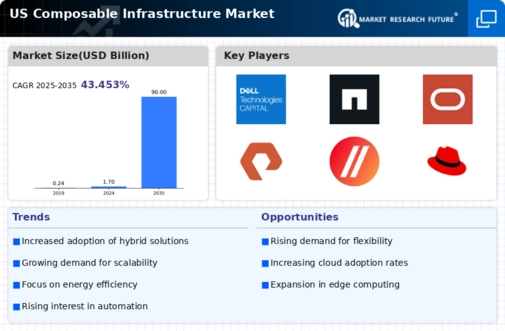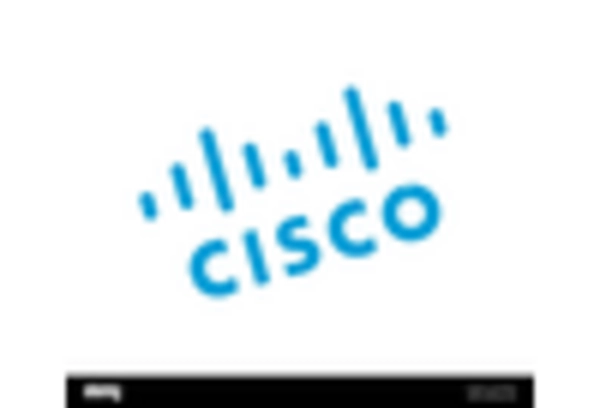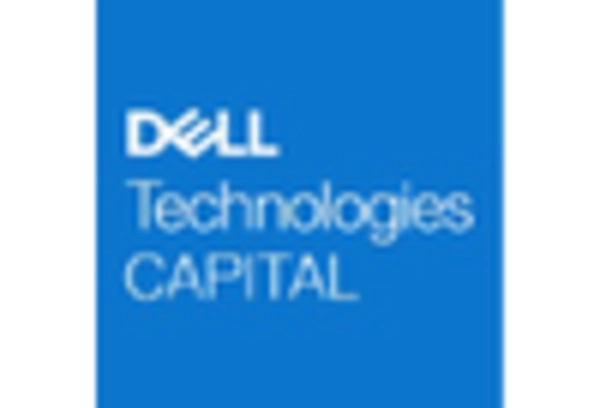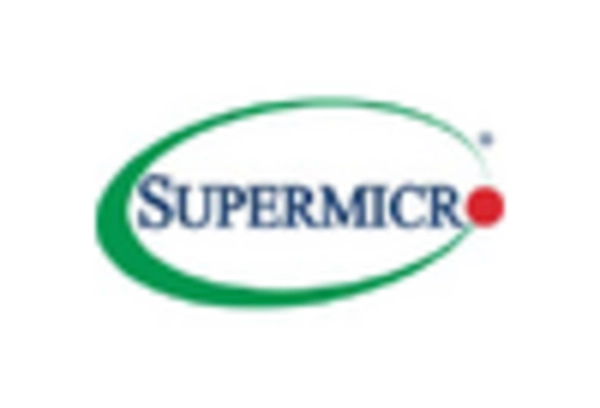Rising Need for Scalability
The composable infrastructure market is experiencing a notable surge in demand for scalable solutions. Organizations are increasingly seeking infrastructure that can adapt to fluctuating workloads and business requirements. This need for scalability is driven by the rapid growth of data and the necessity for efficient resource allocation. According to recent data, the market is projected to grow at a CAGR of 25% over the next five years. Companies are recognizing that traditional infrastructure models may not suffice in meeting their dynamic needs, thus propelling the adoption of composable infrastructure. This trend is particularly evident in sectors such as finance and healthcare, where agility and responsiveness are paramount. As businesses strive to enhance operational efficiency, the composable infrastructure market is likely to play a pivotal role in enabling organizations to scale their resources effectively.
Enhanced Resource Utilization
In the composable infrastructure market, the emphasis on maximizing resource utilization is becoming increasingly pronounced. Organizations are striving to eliminate resource wastage and optimize their IT investments. Composable infrastructure allows for the dynamic allocation of resources, ensuring that computing power, storage, and networking capabilities are utilized efficiently. This approach not only reduces operational costs but also enhances overall performance. Recent studies indicate that companies adopting composable infrastructure can achieve up to 30% improvement in resource utilization rates. As businesses continue to seek cost-effective solutions, the composable infrastructure market is positioned to benefit from this growing focus on resource optimization. The ability to allocate resources on-demand aligns with the evolving needs of modern enterprises, making composable infrastructure an attractive option for organizations aiming to streamline their operations.
Demand for Improved Security Posture
In the composable infrastructure market, the demand for enhanced security measures is becoming a critical driver. As organizations increasingly migrate to digital platforms, the need to protect sensitive data and maintain compliance with regulations is paramount. Composable infrastructure offers the potential for improved security through its modular architecture, allowing for the implementation of robust security protocols at various layers. Recent surveys indicate that 70% of IT leaders prioritize security when considering infrastructure solutions. This heightened focus on security is likely to propel the adoption of composable infrastructure, as organizations seek to mitigate risks associated with data breaches and cyber threats. The ability to integrate security seamlessly into the infrastructure design aligns with the evolving landscape of cybersecurity, making composable infrastructure an appealing choice for businesses aiming to bolster their security posture.
Shift Towards Software-Defined Solutions
The composable infrastructure market is witnessing a significant shift towards software-defined solutions. Organizations are increasingly recognizing the advantages of software-defined networking and storage, which offer greater flexibility and control over their infrastructure. This trend is indicative of a broader movement towards virtualization and automation in IT environments. By leveraging software-defined technologies, businesses can achieve faster deployment times and improved agility. The market for software-defined solutions is expected to reach $100 billion by 2026, highlighting the growing interest in these technologies. As companies seek to modernize their IT infrastructure, the composable infrastructure market is likely to see increased adoption of software-defined components, enabling organizations to respond swiftly to changing business demands and enhance their competitive edge.
Growing Interest in Multi-Cloud Strategies
The composable infrastructure market is benefiting from the increasing interest in multi-cloud strategies among organizations. As businesses seek to leverage the strengths of various cloud providers, the need for a flexible and adaptable infrastructure becomes evident. Composable infrastructure enables organizations to integrate multiple cloud environments seamlessly, allowing for optimized performance and cost management. Recent data suggests that 60% of enterprises are adopting multi-cloud strategies to enhance their operational resilience. This trend is likely to drive the growth of the composable infrastructure market, as organizations require solutions that can support diverse cloud environments. The ability to manage resources across multiple clouds effectively positions composable infrastructure as a key enabler for businesses aiming to achieve greater agility and innovation in their operations.
















